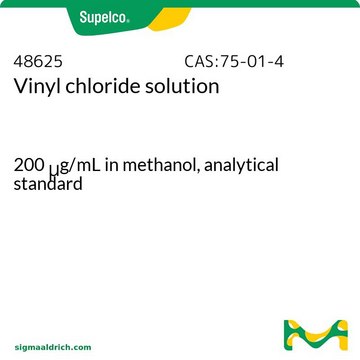46267
Trichloroethylene
analytical standard, stabilized with 30 – 50 ppm Diisopropylamine
Sinônimo(s):
TCE, Trichloroethene
About This Item
Produtos recomendados
grau
analytical standard
Nível de qualidade
densidade de vapor
4.5 (vs air)
pressão de vapor
61 mmHg ( 20 °C)
temperatura de autoignição
770 °F
prazo de validade
limited shelf life, expiry date on the label
técnica(s)
HPLC: suitable
gas chromatography (GC): suitable
índice de refração
n20/D 1.476 (lit.)
p.e.
86.7 °C (lit.)
pf
−84.8 °C (lit.)
densidade
1.463 g/mL at 25 °C (lit.)
aplicação(ões)
cleaning products
cosmetics
environmental
food and beverages
personal care
petroleum
Formato
neat
cadeia de caracteres SMILES
Cl\C=C(\Cl)Cl
InChI
1S/C2HCl3/c3-1-2(4)5/h1H
chave InChI
XSTXAVWGXDQKEL-UHFFFAOYSA-N
Procurando produtos similares? Visita Guia de comparação de produtos
Descrição geral
Aplicação
Produtos recomendados
Palavra indicadora
Danger
Frases de perigo
Declarações de precaução
Classificações de perigo
Aquatic Chronic 3 - Carc. 1B - Eye Irrit. 2 - Muta. 2 - Skin Irrit. 2 - Skin Sens. 1B - STOT SE 3
Órgãos-alvo
Central nervous system
Código de classe de armazenamento
6.1D - Non-combustible acute toxic Cat.3 / toxic hazardous materials or hazardous materials causing chronic effects
Classe de risco de água (WGK)
WGK 3
Ponto de fulgor (°F)
closed cup - does not flash
Ponto de fulgor (°C)
closed cup - does not flash
Equipamento de proteção individual
Eyeshields, Gloves, type ABEK (EN14387) respirator filter
Escolha uma das versões mais recentes:
Já possui este produto?
Encontre a documentação dos produtos que você adquiriu recentemente na biblioteca de documentos.
Protocolos
GC Analysis of Class 2 Residual Solvents on OVI-G43
US EPA Method TO-17: GC Analysis of Volatiles on VOCOL® after Collection/Desorption using Air Toxics Tube
US EPA Method 8260: GC Analysis of Volatiles on SPB®-624 after Purge & Trap using "K" Trap, Fast GC Analysis
Nossa equipe de cientistas tem experiência em todas as áreas de pesquisa, incluindo Life Sciences, ciência de materiais, síntese química, cromatografia, química analítica e muitas outras.
Entre em contato com a assistência técnica









